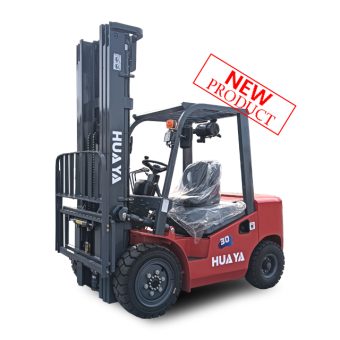
Solutions
We’re here to help:Easy ways to get the answers you need
Our 2 Ton Diesel Forklift by HUAYA combines power and precision for efficient material handling. With robust construction and cutting-edge technology, it’s your ultimate solution for heavy-duty lifting tasks.
Low cost: Affordable initial investment and operational expenses.
Durability: Built to withstand rigorous industrial use, ensuring longevity.
Applicability: Versatile enough to handle various loads and environments.
Comfort: Ergonomic design for operator comfort during long shifts.
Easy maintenance: Simplified maintenance procedures for hassle-free upkeep.
Safety: Equipped with advanced safety features to protect operators and goods.
Advanced Technology: HUAYA forklifts integrate the latest innovations for superior performance and efficiency.
Tailored Solutions: Customizable options to meet specific operational requirements, enhancing productivity.
Robust Construction: The overall standard forging and thick steel steel plate to press the double layer baking paint.
Comprehensive Support: Extensive after-sales service network ensures prompt assistance and maintenance.
Cost-Effectiveness: Optimal balance between initial investment and long-term value, maximizing ROI.
| Item | Unit | Parameter |
| Mast type | stages | 2/3 |
| Lifting height | mm | 3000-7000 |
| Loading Capacity | kg | 2000 |
| Machine weight | kg | 3530 |
| Tires | tires | inflatable / Solid |
| Overall Dimensions | mm | 2530×1160×2060 |
| Load Center | mm | 2250 |
Prioritize operator training and certification, conduct regular inspections, adhere to load capacity limits, and utilize safety features like seat belts and warning systems.
Routine maintenance includes checking fluid levels, inspecting tires and brakes, lubricating moving parts, and servicing the engine and transmission according to manufacturer recommendations.
Issues such as fuel contamination, worn-out components, electrical problems, and improper operation can lead to breakdowns. Regular maintenance and prompt repairs can mitigate these risks.
Practices such as proper load management, efficient route planning, regular engine tune-ups, and training operators in fuel-saving techniques can help optimize fuel consumption and reduce costs.
Implement safety protocols such as providing adequate ventilation in indoor spaces, using explosion-proof equipment where necessary, conducting thorough inspections before operation, and ensuring operators wear appropriate personal protective equipment (PPE).
We have prepared enough various accessories for you to choose from for different purposes.



